YAMAHA NMAX 125 2017 Owner's Manual
Manufacturer: YAMAHA, Model Year: 2017, Model line: NMAX 125, Model: YAMAHA NMAX 125 2017Pages: 94, PDF Size: 3.7 MB
Page 21 of 94
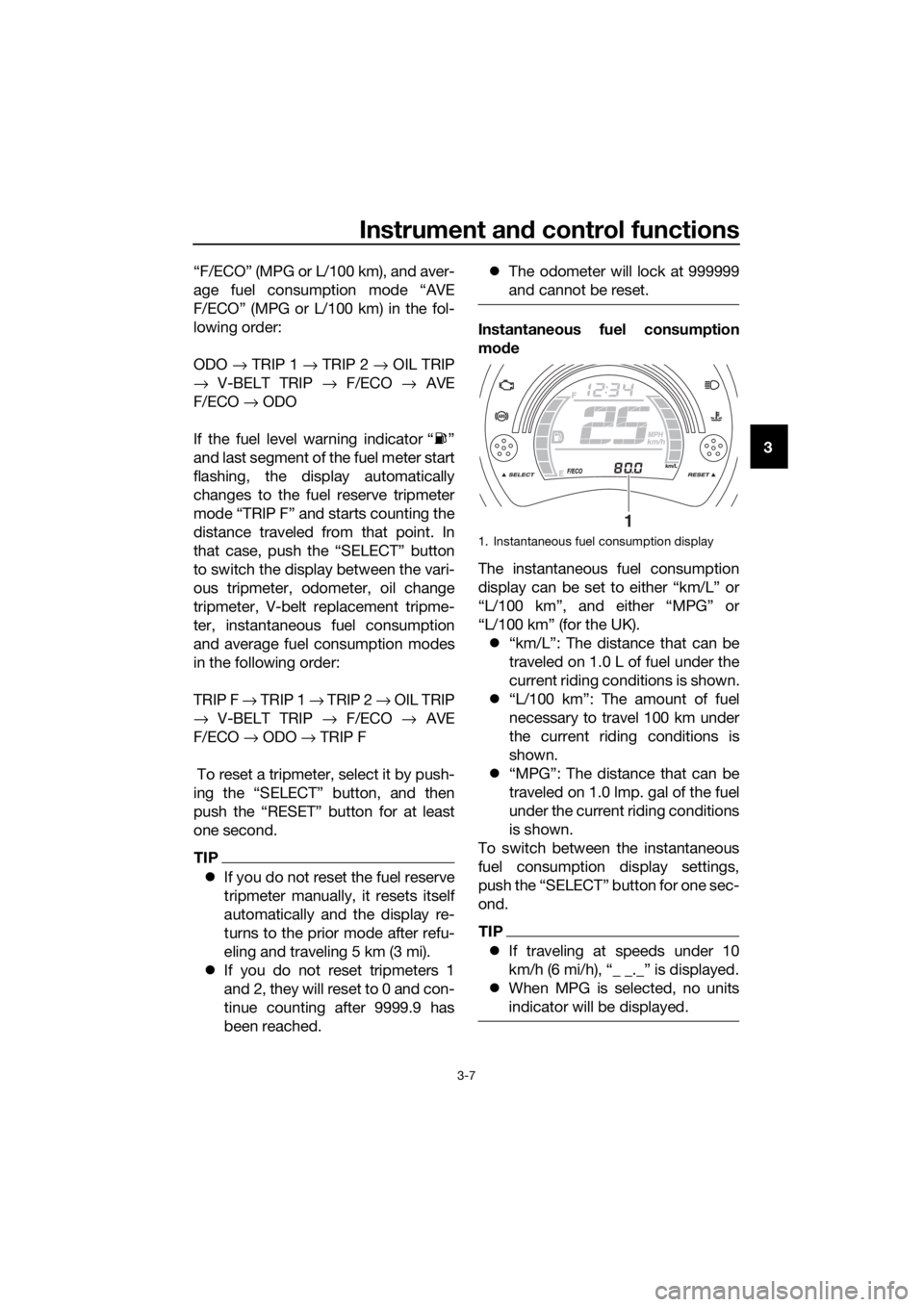
Instrument and control functions
3-7
3
“F/ECO” (MPG or L/100 km), and aver-
age fuel consumption mode “AVE
F/ECO” (MPG or L/100 km) in the fol-
lowing order:
ODO
→ TRIP 1 → TRIP 2 → OIL TRIP
→ V-BELT TRIP → F/ECO → AVE
F/ECO → ODO
If the fuel level warning indicator “ ”
and last segment of the fuel meter start
flashing, the display automatically
changes to the fuel reserve tripmeter
mode “TRIP F” and starts counting the
distance traveled from that point. In
that case, push the “SELECT” button
to switch the display between the vari-
ous tripmeter, odometer, oil change
tripmeter, V-belt replacement tripme-
ter, instantaneous fuel consumption
and average fuel consumption modes
in the following order:
TRIP F → TRIP 1 → TRIP 2 → OIL TRIP
→ V-BELT TRIP → F/ECO → AVE
F/ECO → ODO → TRIP F
To reset a tripmeter, select it by push-
ing the “SELECT” button, and then
push the “RESET” button for at least
one second.
TIP
If you do not reset the fuel reserve
tripmeter manually, it resets itself
automatically and the display re-
turns to the prior mode after refu-
eling and traveling 5 km (3 mi).
If you do not reset tripmeters 1
and 2, they will reset to 0 and con-
tinue counting after 9999.9 has
been reached.
The odometer will lock at 999999
and cannot be reset.
Instantaneous fuel consumption
mo de
The instantaneous fuel consumption
display can be set to either “km/L” or
“L/100 km”, and either “MPG” or
“L/100 km” (for the UK). “km/L”: The distance that can be
traveled on 1.0 L of fuel under the
current riding conditions is shown.
“L/100 km”: The amount of fuel
necessary to travel 100 km under
the current riding conditions is
shown.
“MPG”: The distance that can be
traveled on 1.0 lmp. gal of the fuel
under the current riding conditions
is shown.
To switch between the instantaneous
fuel consumption display settings,
push the “SELECT” button for one sec-
ond.
TIP
If traveling at speeds under 10
km/h (6 mi/h), “_ _._” is displayed.
When MPG is selected, no units
indicator will be displayed.
1. Instantaneous fuel consumption display
1
UBV3E0E0.book Page 7 Monday, September 26, 2016 3:42 PM
Page 22 of 94
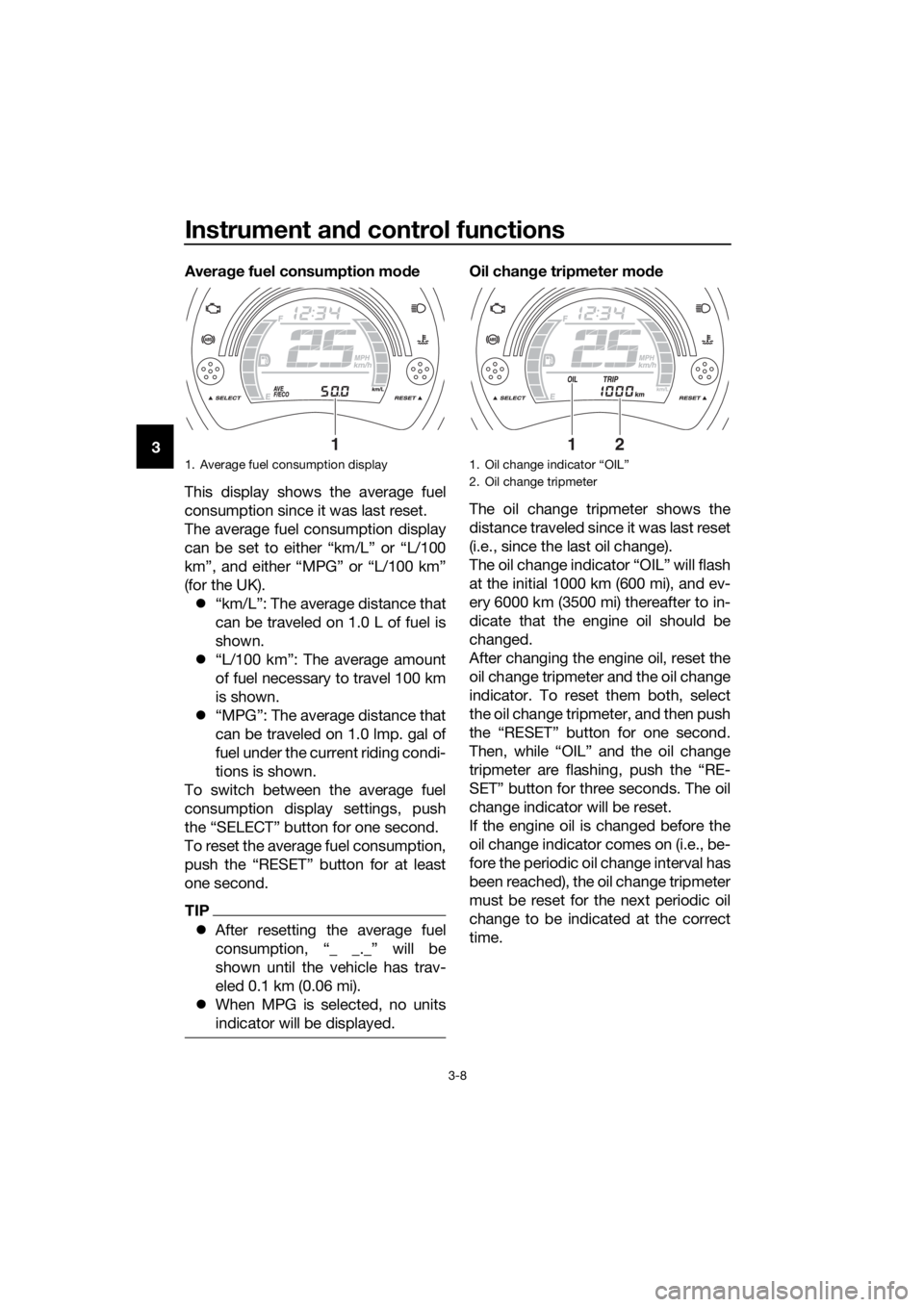
Instrument and control functions
3-8
3 Averag
e fuel consumption mo de
This display shows the average fuel
consumption since it was last reset.
The average fuel consumption display
can be set to either “km/L” or “L/100
km”, and either “MPG” or “L/100 km”
(for the UK). “km/L”: The average distance that
can be traveled on 1.0 L of fuel is
shown.
“L/100 km”: The average amount
of fuel necessary to travel 100 km
is shown.
“MPG”: The average distance that
can be traveled on 1.0 lmp. gal of
fuel under the current riding condi-
tions is shown.
To switch between the average fuel
consumption display settings, push
the “SELECT” button for one second.
To reset the average fuel consumption,
push the “RESET” button for at least
one second.
TIP
After resetting the average fuel
consumption, “_ _._” will be
shown until the vehicle has trav-
eled 0.1 km (0.06 mi).
When MPG is selected, no units
indicator will be displayed.
Oil chan ge tripmeter mo de
The oil change tripmeter shows the
distance traveled since it was last reset
(i.e., since the last oil change).
The oil change indicator “OIL” will flash
at the initial 1000 km (600 mi), and ev-
ery 6000 km (3500 mi) thereafter to in-
dicate that the engine oil should be
changed.
After changing the engine oil, reset the
oil change tripmeter and the oil change
indicator. To reset them both, select
the oil change tripmeter, and then push
the “RESET” button for one second.
Then, while “OIL” and the oil change
tripmeter are flashing, push the “RE-
SET” button for three seconds. The oil
change indicator will be reset.
If the engine oil is changed before the
oil change indicator comes on (i.e., be-
fore the periodic oil change interval has
been reached), the oil change tripmeter
must be reset for the next periodic oil
change to be indicated at the correct
time.
1. Average fuel consumption display
1
1. Oil change indicator “OIL”
2. Oil change tripmeter
21
UBV3E0E0.book Page 8 Monday, September 26, 2016 3:42 PM
Page 23 of 94
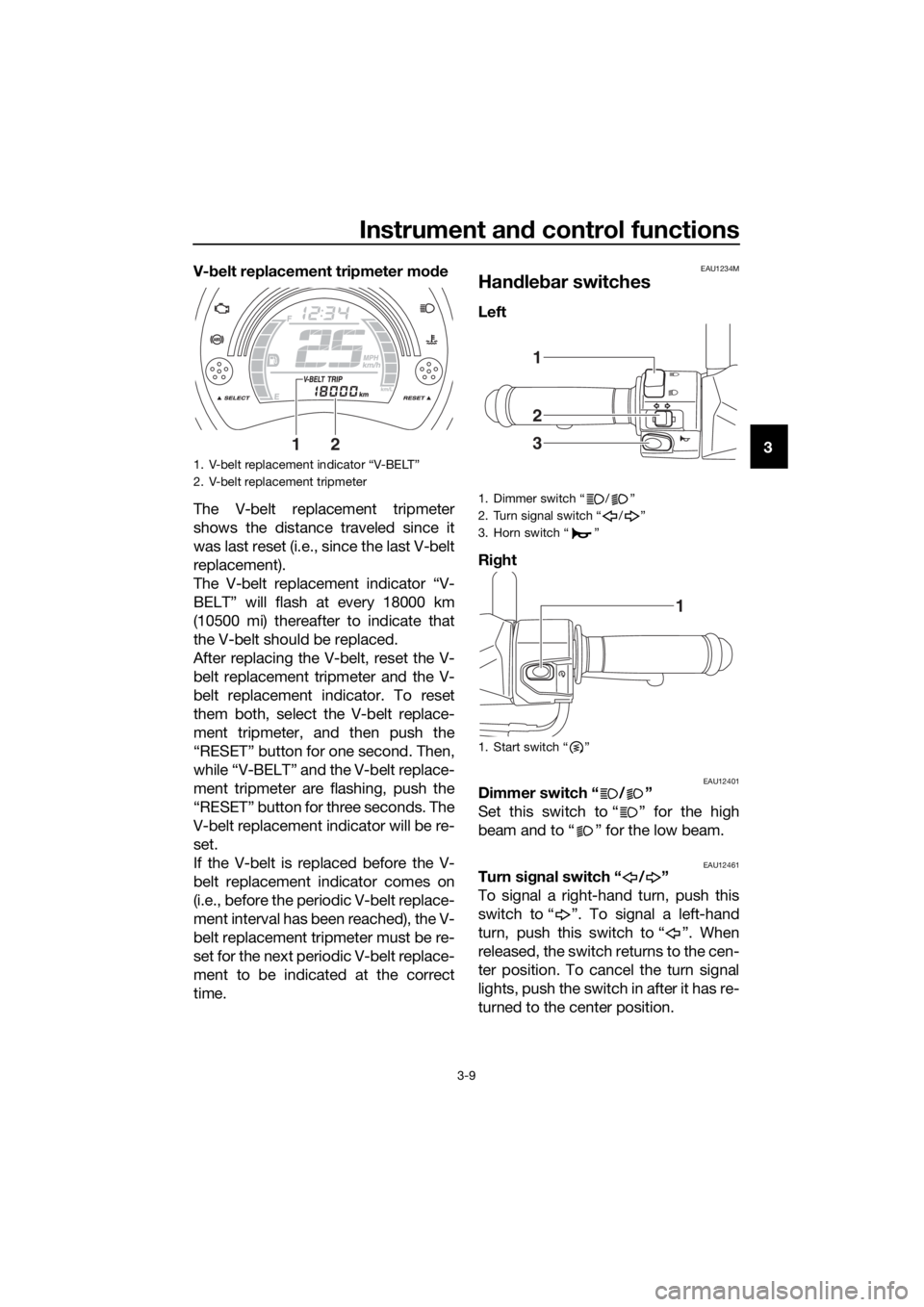
Instrument and control functions
3-9
3
V-
belt replacement tripmeter mo de
The V-belt replacement tripmeter
shows the distance traveled since it
was last reset (i.e., since the last V-belt
replacement).
The V-belt replacement indicator “V-
BELT” will flash at every 18000 km
(10500 mi) thereafter to indicate that
the V-belt should be replaced.
After replacing the V-belt, reset the V-
belt replacement tripmeter and the V-
belt replacement indicator. To reset
them both, select the V-belt replace-
ment tripmeter, and then push the
“RESET” button for one second. Then,
while “V-BELT” and the V-belt replace-
ment tripmeter are flashing, push the
“RESET” button for three seconds. The
V-belt replacement indicator will be re-
set.
If the V-belt is replaced before the V-
belt replacement indicator comes on
(i.e., before the periodic V-belt replace-
ment interval has been reached), the V-
belt replacement tripmeter must be re-
set for the next periodic V-belt replace-
ment to be indicated at the correct
time.
EAU1234M
Han dle bar switches
Left
Ri ght
EAU12401Dimmer switch “ / ”
Set this switch to “ ” for the high
beam and to “ ” for the low beam.
EAU12461Turn si gnal switch “ / ”
To signal a right-hand turn, push this
switch to “ ”. To signal a left-hand
turn, push this switch to “ ”. When
released, the switch returns to the cen-
ter position. To cancel the turn signal
lights, push the switch in after it has re-
turned to the center position.
1. V-belt replacement indicator “V-BELT”
2. V-belt replacement tripmeter
21
1. Dimmer switch “ / ”
2. Turn signal switch “ / ”
3. Horn switch “ ”
1. Start switch “ ”
1
2
3
1
UBV3E0E0.book Page 9 Monday, September 26, 2016 3:42 PM
Page 24 of 94
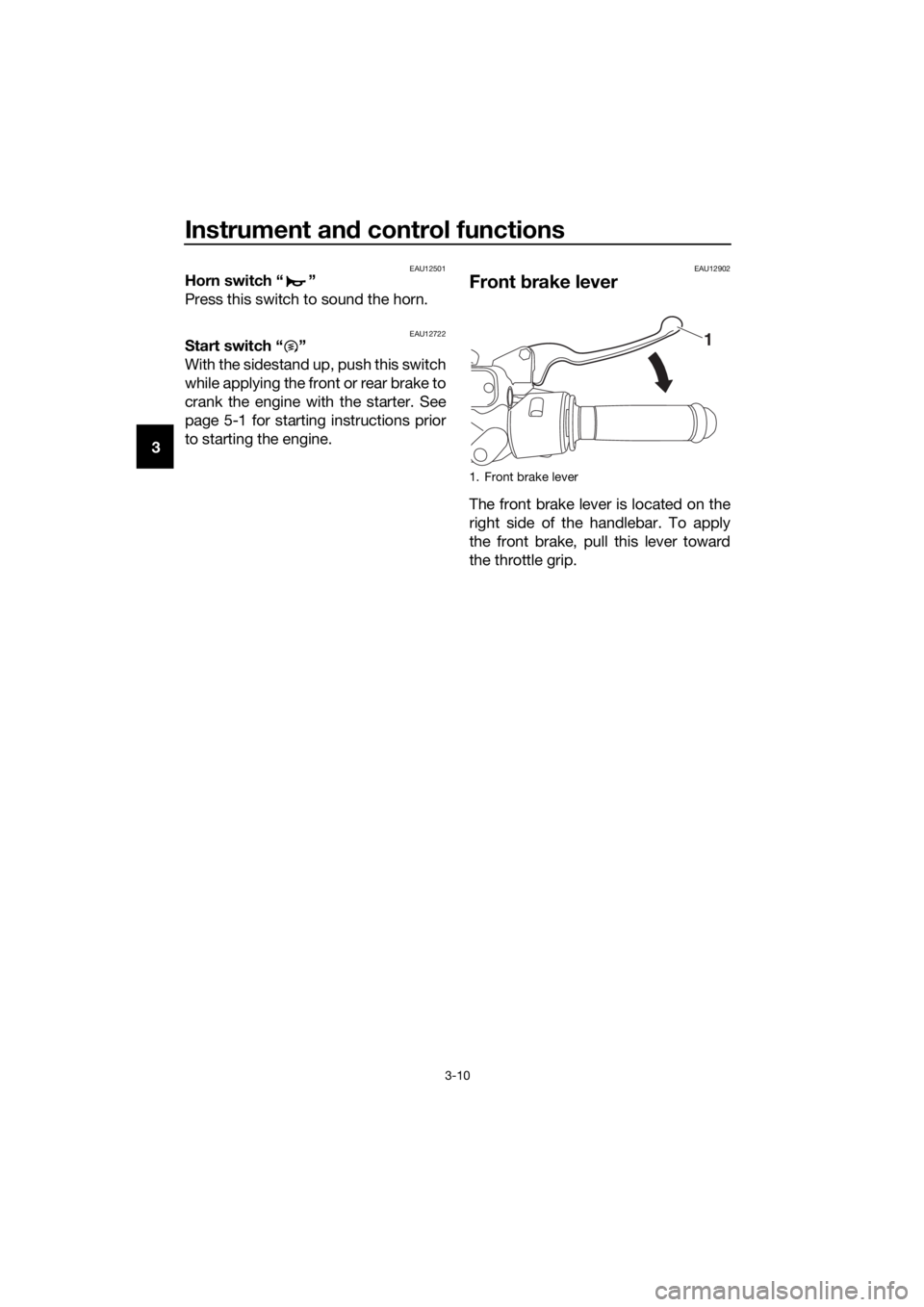
Instrument and control functions
3-10
3
EAU12501Horn switch “ ”
Press this switch to sound the horn.
EAU12722Start switch “ ”
With the sidestand up, push this switch
while applying the front or rear brake to
crank the engine with the starter. See
page 5-1 for starting instructions prior
to starting the engine.
EAU12902
Front brake lever
The front brake lever is located on the
right side of the handlebar. To apply
the front brake, pull this lever toward
the throttle grip.
1. Front brake lever
1
UBV3E0E0.book Page 10 Monday, September 26, 2016 3:42 PM
Page 25 of 94
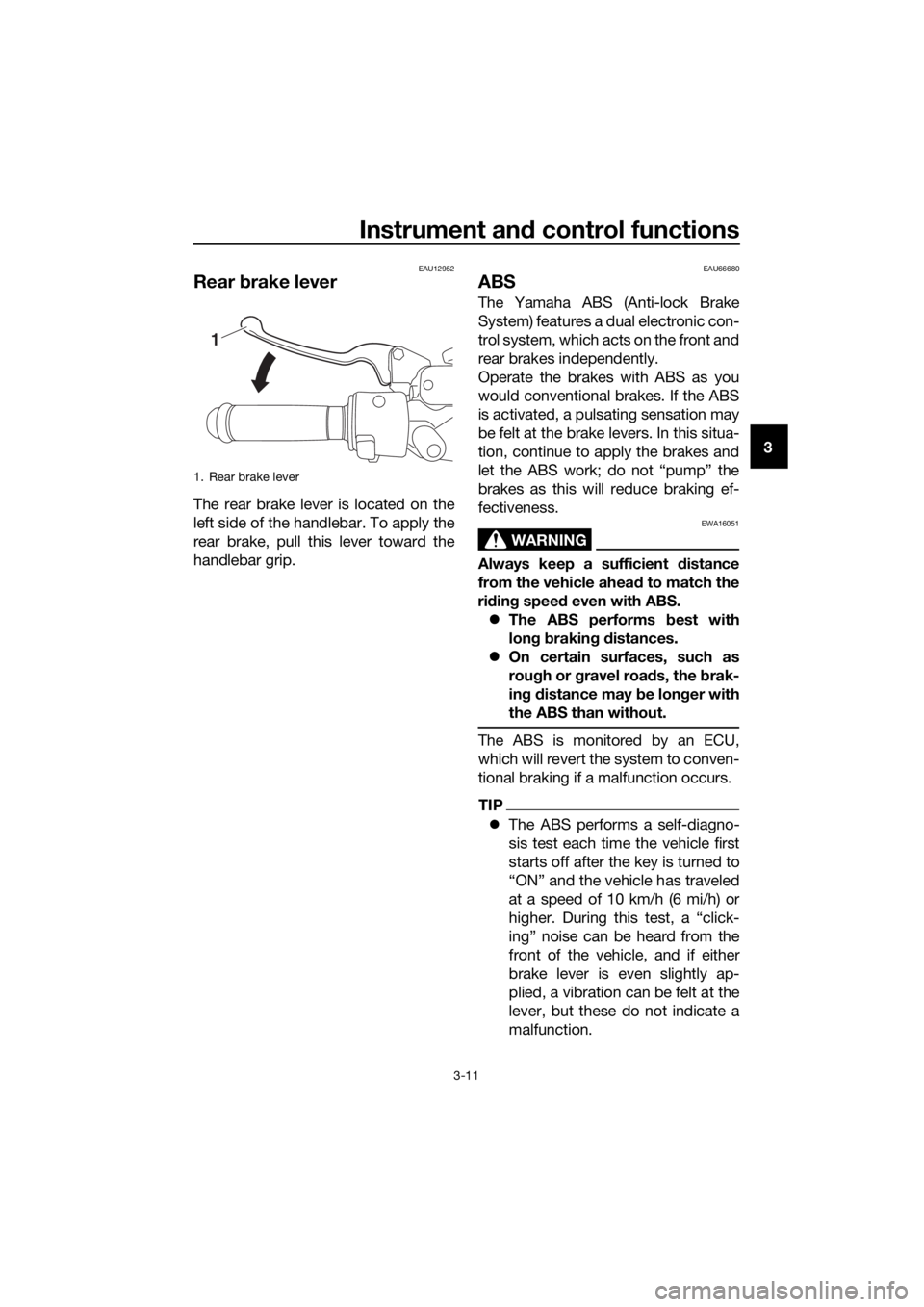
Instrument and control functions
3-11
3
EAU12952
Rear brake lever
The rear brake lever is located on the
left side of the handlebar. To apply the
rear brake, pull this lever toward the
handlebar grip.
EAU66680
ABS
The Yamaha ABS (Anti-lock Brake
System) features a dual electronic con-
trol system, which acts on the front and
rear brakes independently.
Operate the brakes with ABS as you
would conventional brakes. If the ABS
is activated, a pulsating sensation may
be felt at the brake levers. In this situa-
tion, continue to apply the brakes and
let the ABS work; do not “pump” the
brakes as this will reduce braking ef-
fectiveness.
WARNING
EWA16051
Always keep a sufficient distance
from the vehicle ahea d to match the
ri din g speed even with ABS.
The ABS performs best with
lon g b rakin g d istances.
On certain surfaces, such as
rou gh or g ravel roa ds, the b rak-
in g d istance may be lon ger with
the ABS than without.
The ABS is monitored by an ECU,
which will revert the system to conven-
tional braking if a malfunction occurs.
TIP
The ABS performs a self-diagno-
sis test each time the vehicle first
starts off after the key is turned to
“ON” and the vehicle has traveled
at a speed of 10 km/h (6 mi/h) or
higher. During this test, a “click-
ing” noise can be heard from the
front of the vehicle, and if either
brake lever is even slightly ap-
plied, a vibration can be felt at the
lever, but these do not indicate a
malfunction.
1. Rear brake lever
1
UBV3E0E0.book Page 11 Monday, September 26, 2016 3:42 PM
Page 26 of 94
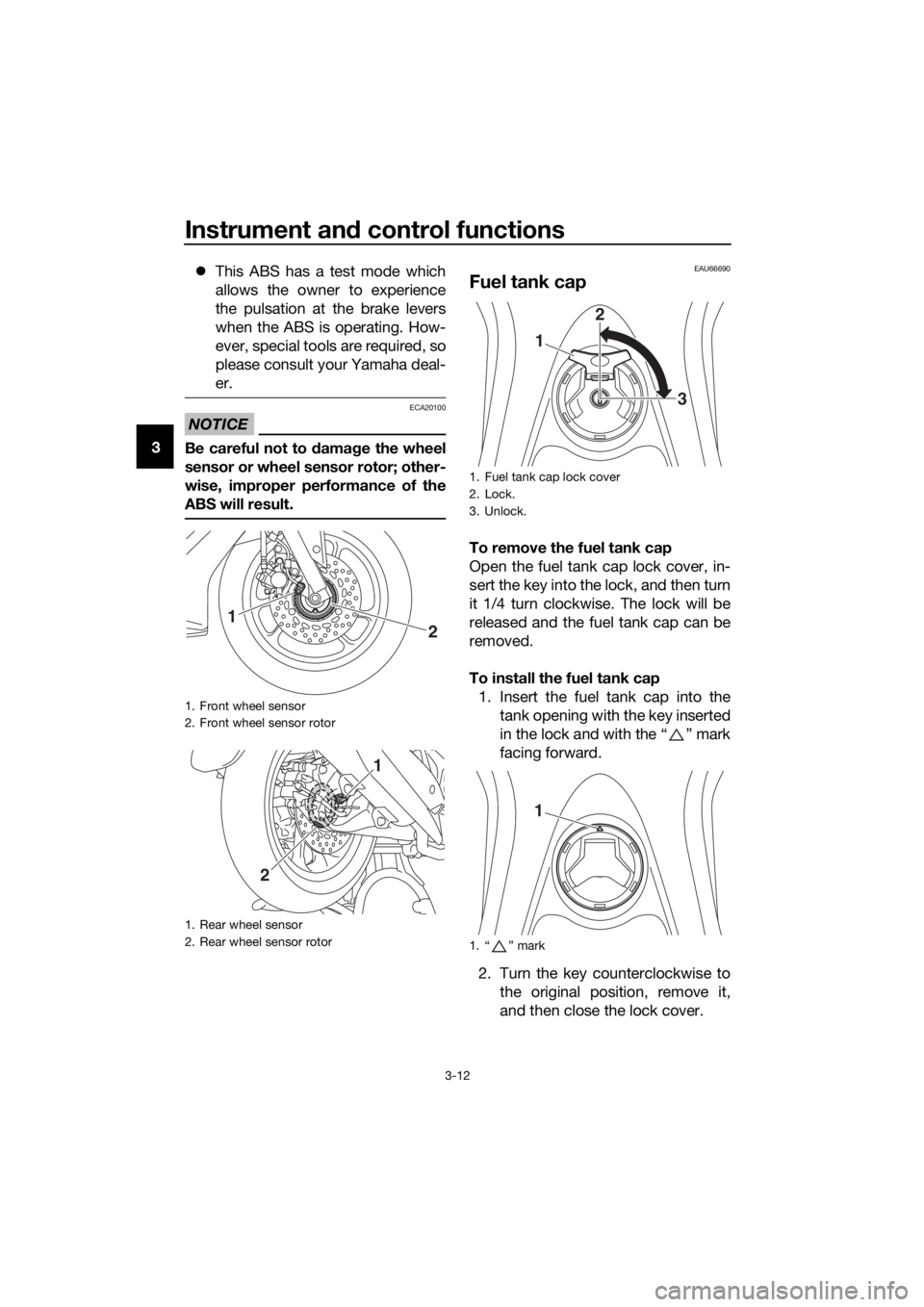
Instrument and control functions
3-12
3
This ABS has a test mode which
allows the owner to experience
the pulsation at the brake levers
when the ABS is operating. How-
ever, special tools are required, so
please consult your Yamaha deal-
er.
NOTICE
ECA20100
Be careful not to damag e the wheel
sensor or wheel sensor rotor; other-
wise, improper performance of the
ABS will result.
EAU66690
Fuel tank cap
To remove the fuel tank cap
Open the fuel tank cap lock cover, in-
sert the key into the lock, and then turn
it 1/4 turn clockwise. The lock will be
released and the fuel tank cap can be
removed.
To install the fuel tank cap 1. Insert the fuel tank cap into the tank opening with the key inserted
in the lock and with the “ ” mark
facing forward.
2. Turn the key counterclockwise to the original position, remove it,
and then close the lock cover.
1. Front wheel sensor
2. Front wheel sensor rotor
1. Rear wheel sensor
2. Rear wheel sensor rotor
2
1
1
2
1. Fuel tank cap lock cover
2. Lock.
3. Unlock.
1. “ ” mark
1 2
3
1
UBV3E0E0.book Page 12 Monday, September 26, 2016 3:42 PM
Page 27 of 94

Instrument and control functions
3-13
3
TIP
The fuel tank cap cannot be installed
unless the key is in the lock. In addi-
tion, the key cannot be removed if the
cap is not properly installed and
locked.
WARNING
EWA10132
Make sure that the fuel tank cap is
properly installe d before ri din g.
Leakin g fuel is a fire hazar d.
EAU13213
Fuel
Make sure there is sufficient gasoline in
the tank.
WARNING
EWA10882
Gasoline an d gasoline vapors are
extremely flamma ble. To avoi d fires
an d explosions an d to re duce the
risk of injury when refuelin g, follow
these instructions.
1. Before refueling, turn off the en- gine and be sure that no one is sit-
ting on the vehicle. Never refuel
while smoking, or while in the vi-
cinity of sparks, open flames, or
other sources of ignition such as
the pilot lights of water heaters
and clothes dryers.
2. Do not overfill the fuel tank. Stop filling when the fuel reaches the
bottom of the filler tube. Because
fuel expands when it heats up,
heat from the engine or the sun
can cause fuel to spill out of the
fuel tank.
3. Wipe up any spilled fuel immedi- ately. NOTICE: Immediately
wipe off spille d fuel with a clean,
1. Fuel tank filler tube
2. Maximum fuel level
2 1
UBV3E0E0.book Page 13 Monday, September 26, 2016 3:42 PM
Page 28 of 94
![YAMAHA NMAX 125 2017 Owners Manual Instrument and control functions
3-14
3 d
ry, soft cloth, since fuel may
d eteriorate painted surfaces or
plastic parts.
[ECA10072]
4. Be sure to securely close the fuel tank cap.
WARNING
EWA15152
G YAMAHA NMAX 125 2017 Owners Manual Instrument and control functions
3-14
3 d
ry, soft cloth, since fuel may
d eteriorate painted surfaces or
plastic parts.
[ECA10072]
4. Be sure to securely close the fuel tank cap.
WARNING
EWA15152
G](/img/51/51080/w960_51080-27.png)
Instrument and control functions
3-14
3 d
ry, soft cloth, since fuel may
d eteriorate painted surfaces or
plastic parts.
[ECA10072]
4. Be sure to securely close the fuel tank cap.
WARNING
EWA15152
Gasoline is poisonous an d can
cause injury or death. Han dle gaso-
line with care. Never siphon gasoline
b y mouth. If you shoul d swallow
some gasoline or inhale a lot of gas-
oline vapor, or get some g asoline in
your eyes, see your doctor imme di-
ately. If g asoline spills on your skin,
wash with soap an d water. If gaso-
line spills on your clothin g, chan ge
your clothes.
EAU76750
NOTICE
ECA11401
Use only unlea ded g asoline. The use
of lea ded g asoline will cause severe
d amag e to internal en gine parts,
such as the valves an d piston rin gs,
as well as to the exhaust system.
TIP
This mark identifies the recom-
mended fuel for this vehicle as
specified by European regulation
(EN228).
Check that gasoline nozzle has
the same identifier when fueling.
Your Yamaha engine has been de-
signed to use regular unleaded gaso-
line with a research octane number of
95 or higher. If knocking (or pinging)
occurs, use a gasoline of a different
brand or premium unleaded fuel. Use
of unleaded fuel will extend spark plug
life and reduce maintenance costs.
Gasohol
There are two types of gasohol: gaso-
hol containing ethanol and that con-
taining methanol. Gasohol containing
ethanol can be used if the ethanol con-
tent does not exceed 10% (E10). Gas-
ohol containing methanol is not
recommended by Yamaha because it
can cause damage to the fuel system
or vehicle performance problems.
Recommen ded fuel:
Regular unleaded gasoline (Gasohol
[E10] acceptable)
Fuel tank capacity: 6.6 L (1.7 US gal, 1.5 Imp.gal)
E10
UBV3E0E0.book Page 14 Monday, September 26, 2016 3:42 PM
Page 29 of 94
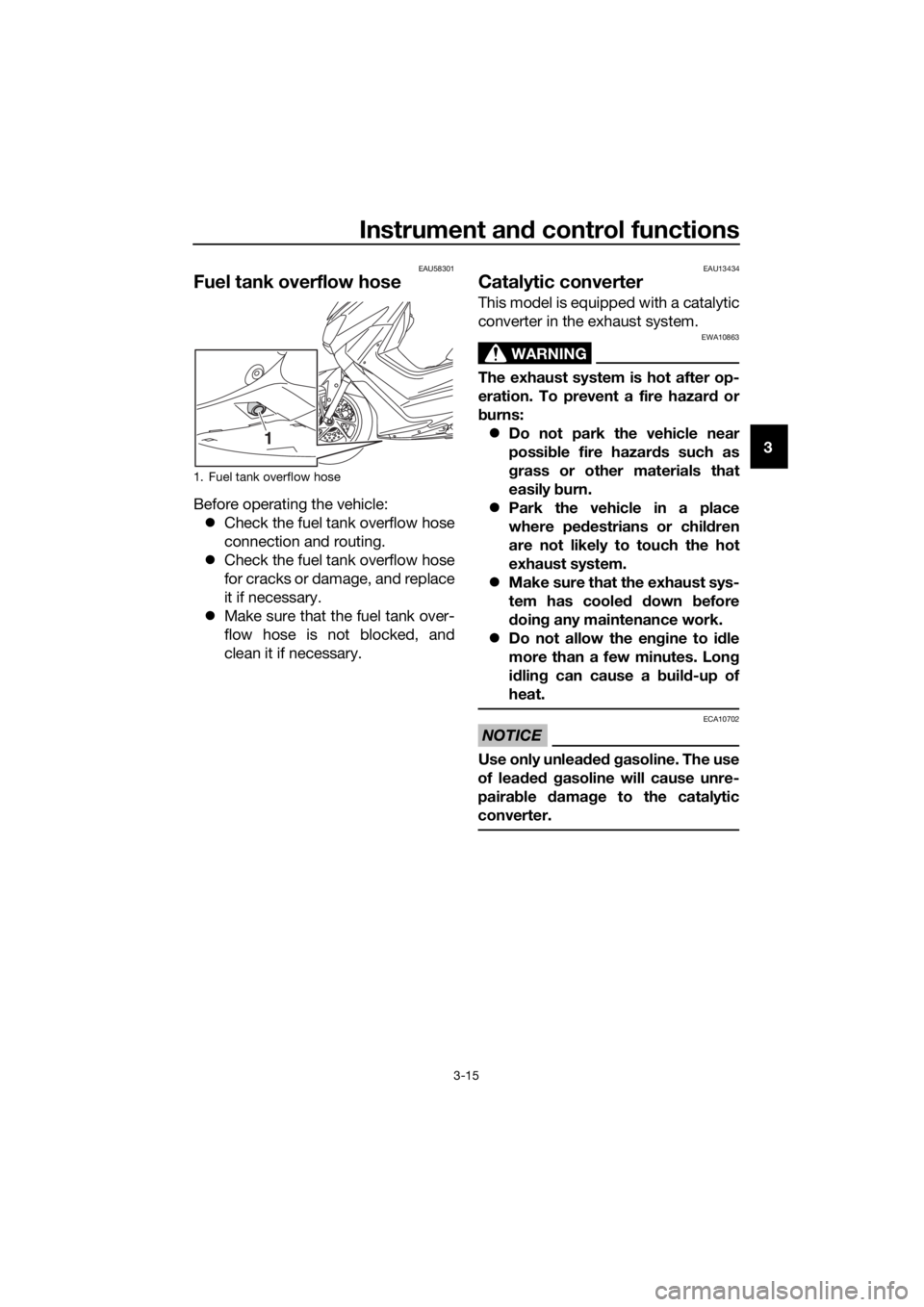
Instrument and control functions
3-15
3
EAU58301
Fuel tank overflow hose
Before operating the vehicle:
Check the fuel tank overflow hose
connection and routing.
Check the fuel tank overflow hose
for cracks or damage, and replace
it if necessary.
Make sure that the fuel tank over-
flow hose is not blocked, and
clean it if necessary.
EAU13434
Catalytic converter
This model is equipped with a catalytic
converter in the exhaust system.
WARNING
EWA10863
The exhaust system is hot after op-
eration. To prevent a fire hazar d or
b urns:
Do not park the vehicle near
possi ble fire hazar ds such as
g rass or other materials that
easily burn.
Park the vehicle in a place
where pe destrians or chil dren
are not likely to touch the hot
exhaust system.
Make sure that the exhaust sys-
tem has coole d down before
d oin g any maintenance work.
Do not allow the en gine to i dle
more than a few minutes. Lon g
i d lin g can cause a b uild-up of
heat.
NOTICE
ECA10702
Use only unlea ded g asoline. The use
of lead ed g asoline will cause unre-
paira ble damag e to the catalytic
converter.
1. Fuel tank overflow hose
1
UBV3E0E0.book Page 15 Monday, September 26, 2016 3:42 PM
Page 30 of 94
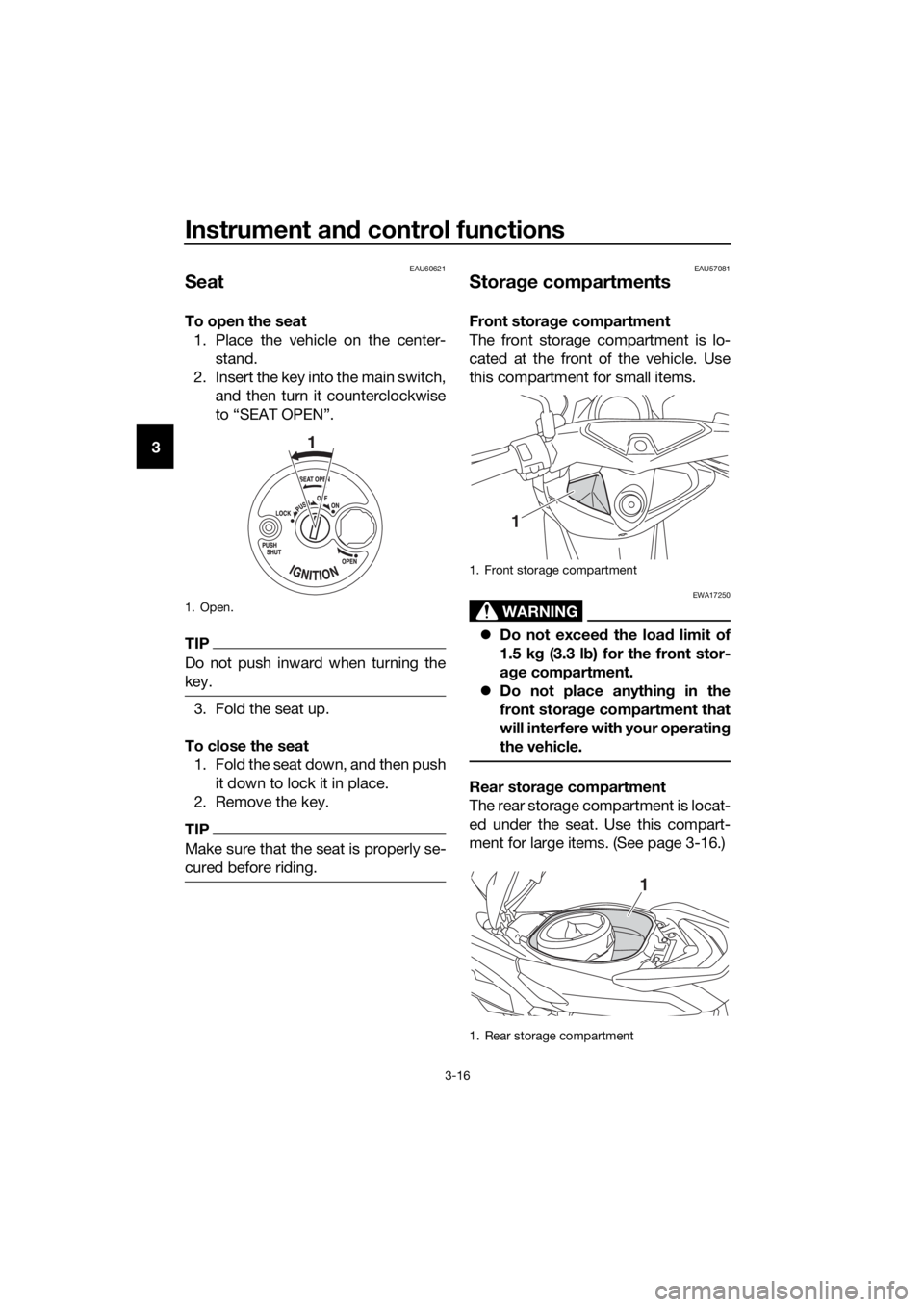
Instrument and control functions
3-16
3
EAU60621
Seat
To open the seat
1. Place the vehicle on the center- stand.
2. Insert the key into the main switch, and then turn it counterclockwise
to “SEAT OPEN”.
TIP
Do not push inward when turning the
key.
3. Fold the seat up.
To close the seat 1. Fold the seat down, and then push it down to lock it in place.
2. Remove the key.
TIP
Make sure that the seat is properly se-
cured before riding.
EAU57081
Stora ge compartments
Front stora ge compartment
The front storage compartment is lo-
cated at the front of the vehicle. Use
this compartment for small items.
WARNING
EWA17250
Do not exceed the load limit of
1.5 k g (3.3 l b) for the front stor-
a g e compartment.
Do not place anythin g in the
front storag e compartment that
will interfere with your operatin g
the vehicle.
Rear stora ge compartment
The rear storage compartment is locat-
ed under the seat. Use this compart-
ment for large items. (See page 3-16.)
1. Open.
1
1. Front storage compartment
1. Rear storage compartment
1
1
UBV3E0E0.book Page 16 Monday, September 26, 2016 3:42 PM